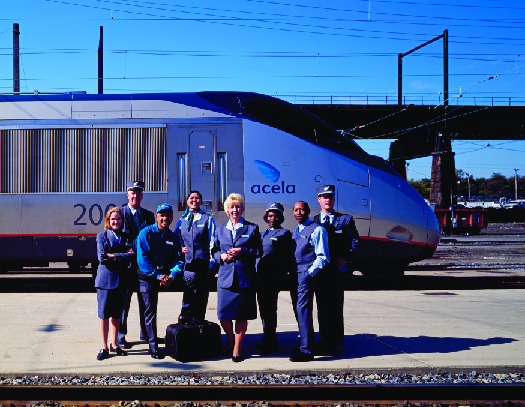| << Chapter < Page | Chapter >> Page > |
The most widely used government corporation is the U.S. Postal Service. Once a cabinet department, it was transformed into a government corporation in the early 1970s. Another widely used government corporation is the National Railroad Passenger Corporation, which uses the trade name Amtrak (
[link] ). Amtrak was the government’s response to the decline in passenger rail travel in the 1950s and 1960s as the automobile came to dominate. Recognizing the need to maintain a passenger rail service despite dwindling profits, the government consolidated the remaining lines and created Amtrak.

Those who work for the public bureaucracy are nearly always citizens, much like those they serve. As such they typically seek similar long-term goals from their employment, namely to be able to pay their bills and save for retirement. However, unlike those who seek employment in the private sector, public bureaucrats tend to have an additional motivator, the desire to accomplish something worthwhile on behalf of their country. In general, individuals attracted to public service display higher levels of public service motivation (PSM). This is a desire most people possess in varying degrees that drives us to seek fulfillment through doing good and contributing in an altruistic manner.
In
Caught between the Dog and the Fireplug, or How to Survive Public Service (2001), author Kenneth
Ashworth provides practical advice for individuals pursuing a career in civil service.
Ashworth says that politicians and civil servants differ in their missions, needs, and motivations, which will eventually reveal differences in their respective characters and, consequently, present a variety of challenges. He maintains that a good civil servant must realize he or she will need to be in the thick of things to provide preeminent service without actually being seen as merely a bureaucrat. Put differently, a bureaucrat walks a fine line between standing up for elected officials and their respective policies—the dog—and at the same time acting in the best interest of the public—the fireplug.
In what ways is the problem identified by author Kenneth Ashworth a consequence of the merit-based civil service?
Bureaucrats must implement and administer a wide range of policies and programs as established by congressional acts or presidential orders. Depending upon the agency’s mission, a bureaucrat’s roles and responsibilities vary greatly, from regulating corporate business and protecting the environment to printing money and purchasing office supplies. Bureaucrats are government officials subject to legislative regulations and procedural guidelines. Because they play a vital role in modern society, they hold managerial and functional positions in government; they form the core of most administrative agencies. Although many top administrators are far removed from the masses, many interact with citizens on a regular basis.
Given the power bureaucrats have to adopt and enforce public policy, they must follow several legislative regulations and procedural guidelines. A regulation is a rule that permits government to restrict or prohibit certain behaviors among individuals and corporations. Bureaucratic rulemaking is a complex process that will be covered in more detail in the following section, but the rulemaking process typically creates procedural guidelines , or more formally, standard operating procedures . These are the rules that lower-level bureaucrats must abide by regardless of the situations they face.
Elected officials are regularly frustrated when bureaucrats seem not follow the path they intended. As a result, the bureaucratic process becomes inundated with red tape . This is the name for the procedures and rules that must be followed to get something done. Citizens frequently criticize the seemingly endless networks of red tape they must navigate in order to effectively utilize bureaucratic services, although these devices are really meant to ensure the bureaucracies function as intended.
To understand why some bureaucracies act the way they do, sociologists have developed a handful of models. With the exception of the ideal bureaucracy described by Max Weber, these models see bureaucracies as self-serving. Harnessing self-serving instincts to make the bureaucracy work the way it was intended is a constant task for elected officials. One of the ways elected officials have tried to grapple with this problem is by designing different types of bureaucracies with different functions. These types include cabinet departments, independent regulatory agencies, independent executive agencies, and government corporations.

Notification Switch
Would you like to follow the 'American government' conversation and receive update notifications?